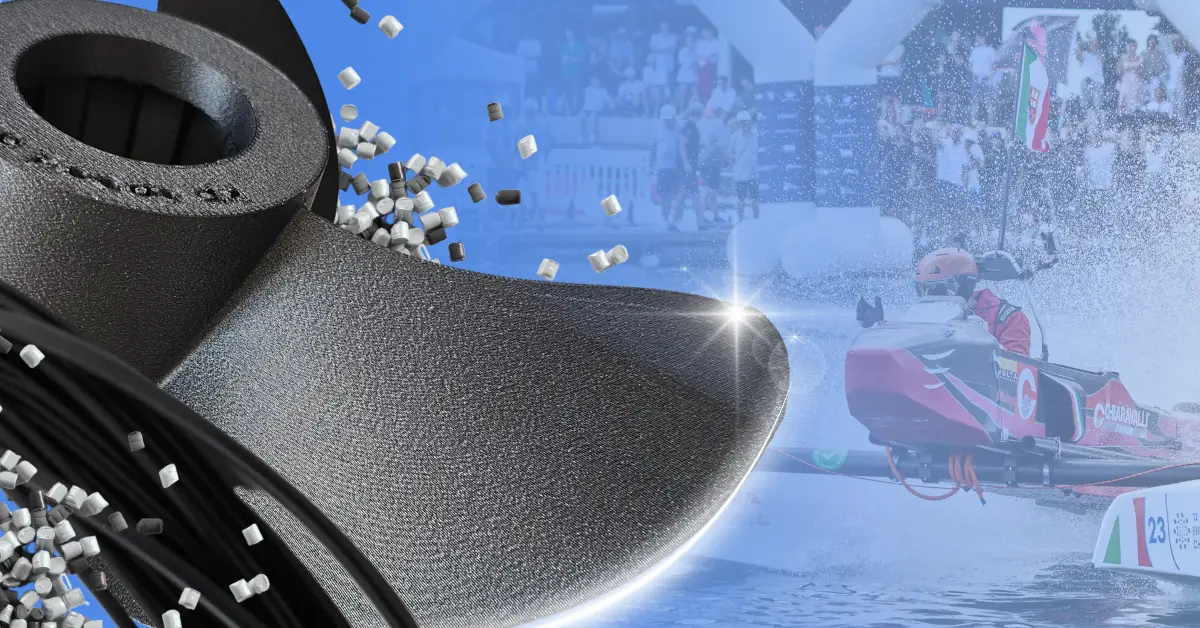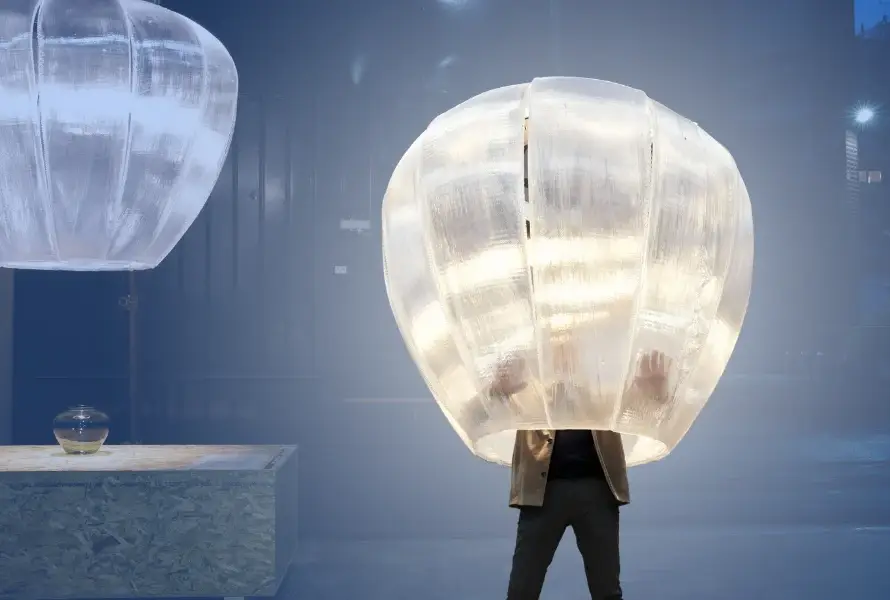Additive Manufacturing for Sustainable Boating
LATI3Dlab and Physis LAB, a spin-off of Politecnico di Milano, collaborated on the development of functional 3D-printed components for “Marino,” the innovative electric propulsion prototype presented by the Physis PEB team at the Monaco Energy Boat Challenge 2025.
This international event is one of the most prestigious showcases for innovation in the energy transition of the marine sector.
Thanks to the use of LATI materials for additive manufacturing (AM), it was possible to produce complex, lightweight, and robust parts, ready for functional testing under real operating conditions.
Materials Used for the “Marino” Boat
The LATI3Dlab materials used for the Marino vessel are two:
- PC/PBT 10CF (LATIBLEND 7587 AM K/10): used for the 3D printing of the propeller, it combines stiffness, mechanical strength, and dimensional stability even in marine environments.
- PETG V0 (LATER G AM UVH-V0): chosen for the battery support, it ensures V0 self-extinguishing behavior even at reduced thicknesses, along with excellent dimensional stability.
These solutions confirm how LATI AM technical filaments allow overcoming the limitations of traditional technologies, paving the way for components intended not only for prototyping but also for small industrial series.
LATI3Dlab and Physis LAB Present the “Marino” Project
We asked Francesco Manarini, Product Development Manager at LATI and LATI3Dlab, to explain in detail the features of the AM materials used:
- Why was PC/PBT 10CF chosen for the propeller and PETG V0 for the battery support?
The propeller is one of the most important components of the boat; therefore, it was essential to have a material that guarantees excellent dimensional stability, chemical resistance to seawater, and above all, outstanding mechanical properties in terms of stiffness and tensile strength. Our PC/PBT 10CF blend (LATIBLEND 7587 AM K/10) fully met all these requirements.
PETG V0 (LATER G AM UVH-V0) was instead selected for its V0 self-extinguishing properties, maintained even at reduced thicknesses. Both materials were also chosen for their printability, even with non-professional filament printers, such as those from BambuLab. - How do LATI materials for additive manufacturing open new possibilities compared to traditional technologies?
The advantages are numerous. In particular, when producing a small number of pieces for prototypes or small series, 3D printing allows testing different functional geometries directly in the field, progressively improving the design to make it more effective.
Moreover, 3D printing offers a geometric freedom hardly achievable with traditional and more expensive technologies such as injection molding. - Beyond boating, which other industrial sectors could benefit from these solutions?
All sectors that do not require large-scale component production, such as prototyping, racing, railway, or industrial, can benefit from these technologies, avoiding the need to develop costly injection molds.
The development of increasingly technical and functional materials – an activity LATI3Dlab has been working on for several years, will also enable reliable and high-performance components, paving the way for larger-scale sectors, such as automotive spare parts. - How important is it for LATI to collaborate with academic institutions and research teams such as Physis LAB to test materials in real scenarios?
It has always been part of the DNA of LATI and LATI3Dlab’s R&D to believe that collaboration with academia can generate new ideas and stimuli for the development of research projects and innovative applications. In particular, with Politecnico di Milano, where many of LATI’s engineers come from, a solid collaboration has been established over time, leading to significant results, scientific articles, and publications.
Physis LAB on the “Marino” Project
We asked Gabriele Defendini (Mechanical Technical Director), Francesco Pagani (Powertrain Unit Coordinator), Ginevra Pagano (Powertrain Unit Coordinator), and Lorenzo Piccinelli (Structures Unit Coordinator and Pilot) to describe Marino and how our materials supported the project:
- How was the “Marino” project born and what was your main ambition in participating in the Monaco Energy Boat Challenge?
Back in 2024, we challenged ourselves by developing a contra-rotating transmission to integrate into an existing outboard leg provided by a sponsor. It was a valuable experience, allowing us to gain expertise and understand the limits of working on a predefined base. For the 2025 edition, however, we wanted to take on a more ambitious challenge: designing a completely new outboard leg from scratch, making us more competitive and aligned with the growing level of innovation showcased each year at the Monaco Energy Boat Challenge.
From this vision, MARINO was born, a modular, lightweight, high-performance electric propulsion system designed for competitive and recreational boating.
Our ambition was twofold: on one hand, to compete internationally with a motor entirely designed by us; on the other, to highlight that innovation can also come from a group of young engineers, not only from large shipyards.
With MARINO, we managed to bridge the technological gap still hindering the electrification of competitive boating, offering a concrete solution that combines performance, modularity, and sustainability. - What are the main features that make “Marino” an innovative prototype compared to traditional solutions?
The real innovation of MARINO lies in its modular architecture: every component, from the propeller to the motor, is interchangeable, allowing quick reconfiguration of the system – for example, switching from dual contra-rotating propellers to a single propeller or surface propeller directly at the dock.
Another distinctive feature is compatibility with different electric systems: thanks to the modular transmission, it is not tied to a single electric motor, unlike the more common closed solutions on the market. Performance goes hand in hand with lightness: weighing less than 40 kg, MARINO supports up to 60 kW of power, achieving an unrivaled power-to-weight ratio in its category.
Sustainability was considered from the outset: components are designed to be reused in different contexts, easily recycled at end of life, and we are developing software that monitors efficiency and suggests smart reuse strategies.
In summary, our prototype represents a technological leap forward because it combines flexibility, sustainability, and performance in a single system, offering a concrete response to the electric transition in both sports and professional boating. - What were the biggest technical challenges in designing and building the electric propulsion system?
The main challenge was combining high performance with extremely low weight without sacrificing system robustness. To achieve this, we had to work very precisely on geometries, materials, and finishes, ensuring resistance to the most critical stresses of competitive navigation, such as sudden accelerations, tight turns, and possible impacts.
Another difficulty was related to the constraints imposed by the components and tools provided by our partners and sponsors. This pushed us to constantly find the right compromise between innovation, production efficiency, and concrete feasibility, seeking creative engineering solutions that allowed us to meet requirements without sacrificing performance and reliability.
Overcoming these challenges allowed us to turn every obstacle into an opportunity for growth, making the project more solid, high-performing, and ready to face new scenarios. - How did LATI materials make a difference in building the functional parts of the vessel?
The collaboration between Physis PEB and LATI3Dlab was fundamental for the development of Nydra (our 2025 prototype) and Marino. Over the years, we have managed to develop and test a range of FDM 3D printing filaments, ranging from eco-sustainable solutions to high-performance materials, surpassing our previous limitations.
Together, we also prototyped new materials not yet available on the market at the time of development, which later found practical applications.
The peak of this synergy was achieved with LATIBLEND 7587 AM K/10, a carbon-fiber-reinforced polycarbonate polymer that ensures high mechanical strength and dimensional stability. Thanks to this material, it was possible to efficiently manufacture the propellers, minimizing resistant sections while increasing overall performance.
A crucial role was also played by LATER G AM UVH-V0HF, a PETG compounded to achieve V0 self-extinguishing class, as well as outstanding UV and hydrolysis resistance. These properties made it ideal for building Marino’s head unit, constantly exposed to sunlight and external agents.
Finally, LATICONTHER SP4 AM CP1 30 was effectively used for manufacturing the heat exchanger components of the inverter. The ceramic filler in this polyamide-based polymer improved thermal exchange within the cooling circuit.
The collaboration between LATI3Dlab and Physis LAB demonstrates how 3D printing materials can represent a concrete solution for the energy transition in boating and beyond. With projects like “Marino,” additive manufacturing is no longer just a prototyping tool but becomes a true technological enabler for functional, lightweight, high-performance, and sustainable components.


